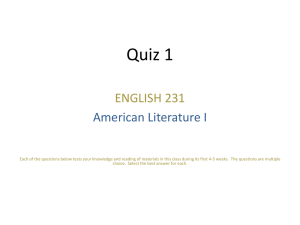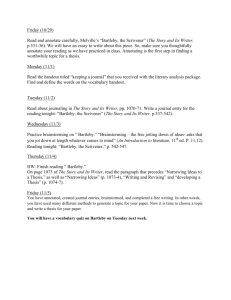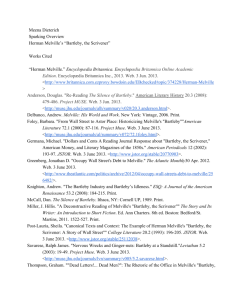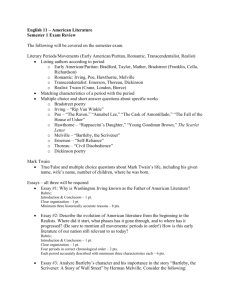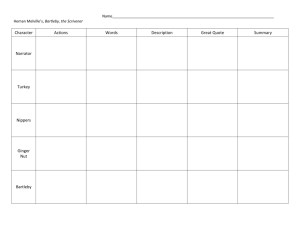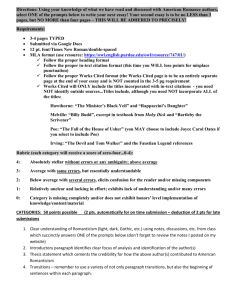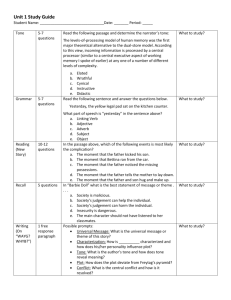File
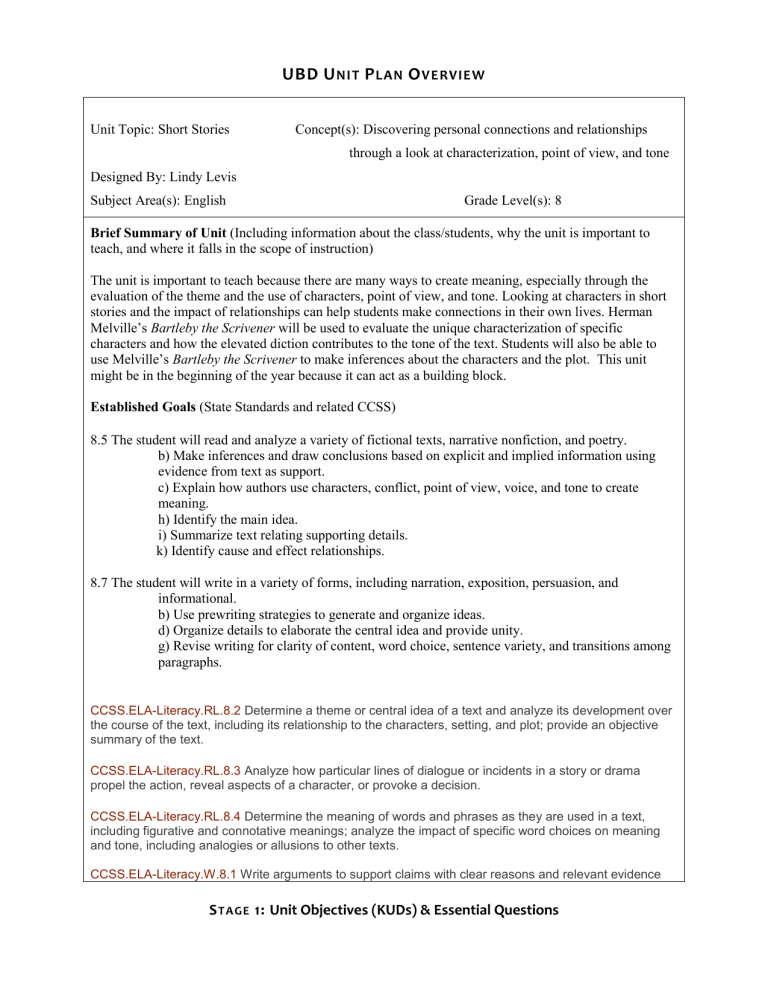
UBD U
NIT
P
LAN
O
VERVIEW
Unit Topic: Short Stories Concept(s): Discovering personal connections and relationships
through a look at characterization, point of view, and tone
Designed By: Lindy Levis
Subject Area(s): English Grade Level(s): 8
Brief Summary of Unit (Including information about the class/students, why the unit is important to teach, and where it falls in the scope of instruction)
The unit is important to teach because there are many ways to create meaning, especially through the evaluation of the theme and the use of characters, point of view, and tone. Looking at characters in short stories and the impact of relationships can help students make connections in their own lives. Herman
Melville’s Bartleby the Scrivener will be used to evaluate the unique characterization of specific characters and how the elevated diction contributes to the tone of the text. Students will also be able to use Melville’s Bartleby the Scrivener to make inferences about the characters and the plot. This unit might be in the beginning of the year because it can act as a building block.
Established Goals (State Standards and related CCSS)
8.5 The student will read and analyze a variety of fictional texts, narrative nonfiction, and poetry. b) Make inferences and draw conclusions based on explicit and implied information using evidence from text as support. c) Explain how authors use characters, conflict, point of view, voice, and tone to create meaning. h) Identify the main idea. i) Summarize text relating supporting details.
k) Identify cause and effect relationships.
8.7 The student will write in a variety of forms, including narration, exposition, persuasion, and informational. b) Use prewriting strategies to generate and organize ideas. d) Organize details to elaborate the central idea and provide unity. g) Revise writing for clarity of content, word choice, sentence variety, and transitions among paragraphs.
CCSS.ELA-Literacy.RL.8.2
Determine a theme or central idea of a text and analyze its development over the course of the text, including its relationship to the characters, setting, and plot; provide an objective summary of the text.
CCSS.ELA-Literacy.RL.8.3
Analyze how particular lines of dialogue or incidents in a story or drama propel the action, reveal aspects of a character, or provoke a decision.
CCSS.ELA-Literacy.RL.8.4
Determine the meaning of words and phrases as they are used in a text, including figurative and connotative meanings; analyze the impact of specific word choices on meaning and tone, including analogies or allusions to other texts.
CCSS.ELA-Literacy.W.8.1
Write arguments to support claims with clear reasons and relevant evidence
S T A GE 1: Unit Objectives (KUDs) & Essential Questions
As a result of this unit of instruction, students will…
Understand THAT…
…an author uses elements of characterization to create meaning for characters
…an author’s tone stems from the stylized use of literary devices
…the point of view impacts the meaning of the text and how the audience interprets the text
…cause-effect relationships impact the plot
Know…
K1: Main idea is the most important or central thought in a text.
K2: Theme is a common thread or repeated idea that is incorporated throughout a literary work.
K3: Characterization is the way that an author presents a character and reveals character traits.
K4: Tone is used to express a writer’s attitude toward the subject.
K5: Point of view is the way an author reveals events and ideas in a story. With an omniscient or “all knowing” point of view, a narrator sees all, hears all, and knows all. By contrast, a limited point of view depicts only what one character or narrator sees, hears, and feels.
The point of view may be first person, narrated by someone outside the story or a character within the story.
K6: Inferences include making judgments or drawing conclusions based on what an author has implied.
K7: The main ideas and themes present in Herman
Melville’s Bartleby the Scrivener .
K8: Melville’s use of physical description and personality traits to describe the four main characters in
Bartleby the Scrivener – the Lawyer, Turkey, Nippers, and Bartleby.
K9: Melville’s diction and vocabulary choice affects the tone of Bartleby the Scrivener.
K10: Bartleby the Scrivener is told from the Lawyer’s perspective, which is first person narration.
How does someone create meaning through characters?
How does someone create meaning using tone?
How does the point of view impact the meaning of a text?
What ways can cause-effect relationships impact the plot?
Explore these ESSENTIAL QUESTIONS…
Be able to (Do—include Bloom’s)…
Identify the main idea and the theme.
Analyze the interactions between individuals, events, and ideas in a text (e.g., how ideas influence individuals or events, or how individuals influence ideas or events).
Analyze how particular lines of dialogue or incidents in a story or drama propel the action, reveal aspects of a character, or provoke a decision.
Evaluate the cause-effect relationships within a text and analyze their impact on the plot.
Identify an author’s point of view or purpose in a text.
Analyze how differences in points of view can create such effects as suspense or humor.
Understand and analyze elements of an author’s style, including:
dialogue;
tone, including
- serious -enthusiastic
- solemn -humorous
- sarcastic -hostile
- objective -disapproving
- personal -impersonal
Create graphic organizers to analyze and summarize text.
Create a thesis statement that focuses an essay, expresses the writer’s position in an argument, or explains the purpose of the essay, and is usually found in the first paragraph.
S T A GE 2: A S SE S SME N T E VI D E N C E
Performance Assessment: What will students do to show that they have achieved the objectives?
G oal: The goal is for students to see the way that the author, Herman Melville, presents a character and reveals character traits through indirect and direct forms of characterization.
R ole: The student’s job is to create a visual for one of the four characters from the short story
Bartleby the Scrivener. The visual will include a stick-figure representation of the Lawyer,
Bartleby, Turkey, or Nippers, and the student will use words and pictures to show how the author depicts each character.
A udience: The target audience is the other students in the classroom. Other students should be able to see representations of Melville’s indirect and direct forms of characterization in their drawings.
S ituation: The context the students find themselves in is using textual evidence from the short story in order to create visual representations of the characters. They will base their assignment off of the physical descriptions in the text and what the author implies about each character.
P erformance/ P roduct: The student will create a drawing of a character from Bartleby the
Scrivener in order to label indirect and direct means of characterization and differentiate between the two forms.
Other Evidence: What formative (ongoing) assessments are used?
Think-pair-share – encourages individual thinking and pair discussion
Oral Questioning – engages learners and challenges them to think in depth about the presented concepts
Journal Entries – used to record individual understandings of a topic
Idea Spinner – students are asked to predict, explain, summarize, or evaluate the material
Hand signals – used as a visual gage of students’ understanding
